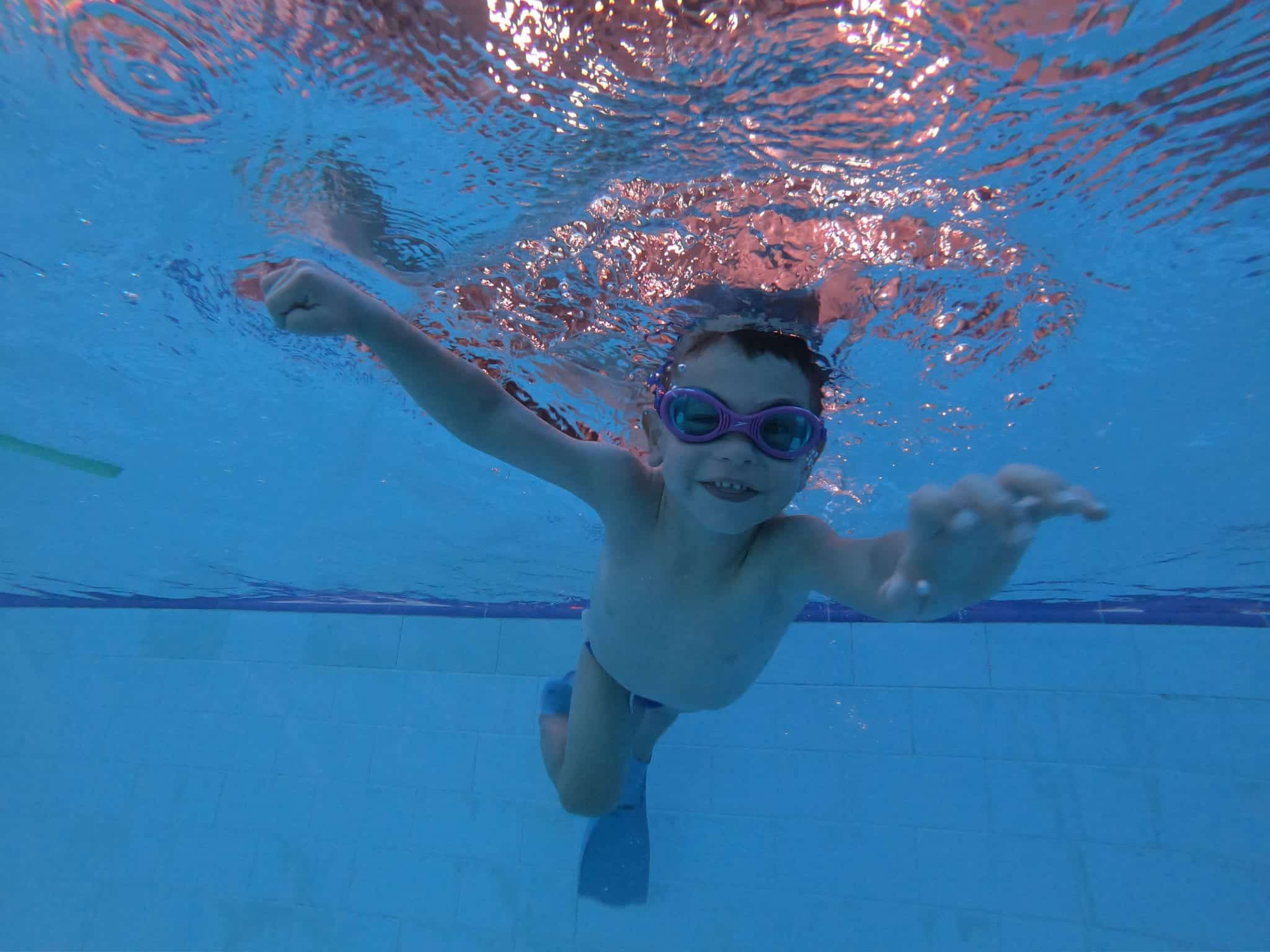Fear of water in children
In the article we will talk about fear of water in children (hydrophobia) and try to answer some of the questions that arise in parents:
– How is fear of water created, and how is it treated?
– What is important for us to know as parents when we have a child with hydrophobia?
– What must not be done with a child who is afraid of water?
– How to choose the right swimming instructor?
– How many times a week is it recommended to bring your child to swimming lessons?
– What can we do as parents to contribute to the process?
How is hydrophobia created?
The reasons for water fear in children are very varied. It may be that for a moment we did not notice, the child slid in the pool and fell into the water, or it may be that soap or water got into the child’s eyes in the bath, quick baths with too hot or too cold water, or drowning. Some say water fear can also be from a previous life. Even a parent with a water fear who is constantly anxious for the child and tells him how dangerous water is can develop an anxious child.
It is important to say that we hear about the worst cases, children who drown in a private pool, drift to the open sea and more, but there are hundreds and perhaps thousands of cases a year of children who, just for the moment, when the parents weren’t looking, drown. No harm comes to the child, but from that moment he develops hydrophobia.
A crazy statistic that is important to know, and most worrying, is that every weekend there is a kid on every beach whose parents are looking for him!!! Each lifeguard responds to about 400 cases a year. What about those cases on undeclared beaches?
These are hundreds and maybe thousands of children who just drowned a little, rescued, but develop hydrophobia.
In recent years there has been a severe phenomenon of parents who sit on the edge of the pool with their smartphones. We have often seen parents whose child drowned right in front of their eyes, the parent’s feet are in the water, the child drowning right next to them, and because of the cellphone the parent is not focused, neither seeing nor hearing. Fortunately, in most cases a rescuer or another person saves the child.
When a parent tells us “It’ll be fine, I’m watching him/her,” The answer is usually: We trust the parent, but not the cell phone.
A child who suffers from hydrophobia, untreated from an early age, may suffer from it for the rest of his life, and his life will change from end to end, so everything must be done and we must be patient to help him overcome his fear.
What should we do when our child has hydrophobia?
• Never ask the child: “Why are you scared?” There’s no need to remind him of that.
• Do not throw the child into the water! Throwing a child into the water will only cause more fear.
• Do not compare the child with other children who can swim.
• Do not show your frustration to the child. He needs time, and your impatience won’t help him get into the water faster.
What can you do? Help the child have a positive experience, with pool games and lots of patience.
When should you take your child for private lessons and when for small group lessons?
In most situations, it is recommended to do between 8-12 private lessons in a preliminary phase, or a duo lesson, if both children are afraid, but not in a group.
The key question is – what will cause the child to leave the wall? What will make him smile? And what will make the child want to come next time?
The answer to everything is patience, patience and a little more patience, beyond professional and precise work with an instructor who knows how to work with hydrophobia.
What exercises or games should we do with our children to help them cope with their fear of water?
Buy them water games that they will want to play with, even if it means playing with them out of the water in an initial stage.
The parent must have goggles on, to show the child how funny it can be to have the child splash on them when they have goggles on.
Adaptation starts out of the water – play with the child on the stairs for even an hour, to give him confidence in the pool environment.
Take pictures of the child and ask if it’s okay to show Dad, Mom, Grandma, etc., what a champion he was in the pool.
Always end with a game your child loves very much before he gets out of the water.
Is hydrophobia in children hereditary?
Definitely not!!
Fear of water can be easily passed on from an anxious or extremist parent. In many cases, we see parents with hydrophobia in toddler swimming class. Holding the child scares them, and when they submerges the child they literally stops breathing. But fear itself is not genetic. If parents overcome their fear, the children will not be afraid.
What must we do? Just learn to swim, so as not to pass on our fear and trauma to our children.
What should we never say to a child with hydrophobia?
• Look how he swims!
• Why are you scared? It’s not scary at all!
• Jump to me, don’t worry.
• This time, listen to how the instructor tells you to do things.
Please don’t tell the child how hard it was for you to bring him to the pool and what you did for him. It is not interesting, nor does it help his swimming, or helps him overcome his fear.
What to do when we have a child with hydrophobia?
Strengthen, strengthen, smile, tell him to have fun. We want to make this a fun experience.
How to choose an instructor who will succeed with our children’s hydrophobia?
Three things are very important when choosing the right instructor to treat your children’s water fear:
1. It is important that the instructor be patient. Without patience, there is no chance of success in the process.
2. Eyes – You, the parents, can see the eyes of the instructor, and know if this is the right one for you. In Water World we perform a number of tests for instructors who want to work with us, and I can say that the first and most important thing is to look them in the eyes. You can actually see everything you need to know: the calm, the giving, the patience.
3. Another important test is working with children ages 3 and under. A 3-year-old requires a lot: games, creativity, exercises, energy, so an instructor who knows how to work with a 3-year-old and teach him swimming (not just games) is an instructor who can work as well with fear of water in all ages.
The steps to teaching a child with water fear how to swim
There is no second chance for first impressions
There is no second attempt if the first one doesn’t work or, in other words, the child’s initial encounter with the water must succeed.
When it comes to water fear, this sentence is very important, so the steps in the Water World method are critical.
The first encounter must be funny, enjoyable. Progress is not important. What’s important is establishing a relationship between the instructor / therapist and the child.
In this first session, we, the instructors, must be ready with a number of games such as a ball, dolphin squirting toy, hoops and more. There are instructors who have such a personal charm that they just give one high-five to a child and he relaxes and wants to get in the water (all the professional managers in Water World are like this).
Under no circumstances should a child with hydrophobia be told: “Come on!” There is no such thing when it comes to a child with water fear. There is no such thing as too much out-of-water games, and it’s very important for parents to understand that. If we get the child into the water one second before he’s ready, we can ruin the whole process.
Splashing on the instructor – We must create a game that will make the child realize it’s funny in the water, especially when using goggles.
How to get the child into the water?
One of the best ways is to let him throw an object he really loves in the water, and as soon as he does to ask him if he wants to help bring it back. This moment is one of the most important moments in the child’s confidence.
Work with fins and a banana right from the start
The banana gives lots of confidence in the water. Slowly, stretch the child’s arms into an arrow position, and this way, without noticing it, he already moves in the water in a swimming position and promotes his swimming, even when his head is out of the water.
Why not make bubbles in the adjustment phase?
(It is recommended to watch the video) A stressed child will squeeze his arms toward the abdomen and his lungs will close. As long as he is stressed, there is a 90% chance that he will swallow water, which is the last thing we want to happen.
The Water World method is a classic fit for hydrophobia – first strengthen the body, shoulder belt and breath, and then make bubbles only when the child is ready.
Extension and strengthening of the shoulder belt
The goal is to create a kind of arrow, with palms against each other. When this happens you can not only strengthen the shoulder belt but also lengthen the muscles, and then the child can actually start swimming.
** It is important to know that there is no one way to deal with hydrophobia, and every child takes a different amount of time to deal with trauma or anxiety, so you should smile, strengthen your child, persevere, and if there are any questions, the Water World team can always be asked.
How many swimming lessons per week are recommended to treat hydrophobia in children?
When it comes to water fear in children, treatment does not begin and end with the swimming lesson, but with the baths, the before and after experience, and the parents’ encouragement for the process.
For children, it is recommended to take swimming lessons once or twice a week. Fewer than that is ineffective, and more than that can be unnecessary and difficult for a child.
We, in Water World, like to give a child with hydrophobia one private lesson a week, unless there’s added difficulty such as hypotonia (muscle weakness) and especially weakness in the shoulder belt or breath, in which case it is worth doing twice a week.
Parenting Tips for Success When it comes to hydrophobia
• Film the child in class, show him how excellent he was and show the videos to all the family members.
• Go with him to the store to buy floating water toys of his choice.
• Make sure he has good goggles with anti-fog and really soft silicone. Give the instructor the goggles in the first lesson. The instructor will find the right time to put it on the child.
• Arrive about 20 minutes before class – do not run and arrive at the last minute. The child needs a proper adjustment to the place and scene as well.
• Let the child see a smiling picture of the instructor, before class.
• Understand that any child can succeed in dealing with water fear and swim, you just have to have patience for the process.
Good Luck!
Water World Team



